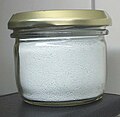Theory

All atoms and molecules are capable of absorbing and releasing energy in the form of photons, accompanied by a change of quantum state. The amount of energy absorbed or released is the difference between the energies of the two quantum states. There are various types of quantum state, including, for example, the rotational and vibrational states of a molecule. However the release of energy visible to the human eye, commonly referred to as visible light, spans the wavelengths approximately 380 nm to 760 nm, depending on the individual, and photons in this range usually accompany a change in atomic or molecular orbital quantum state. The perception of light is governed by three types of color receptors in the eye, which are sensitive to different ranges of wavelength within this band.
The relationship between energy and wavelength is determined by the Planck-Einstein relation
where E is the energy of the quantum (photon), f is the frequency of the light wave, h is the Planck constant, λ is the wavelength and c is the speed of light.
The relationships between the energies of the various quantum states are treated by atomic orbital, molecular orbital, Ligand Field Theory and Crystal Field Theory. If photons of a particular wavelength are absorbed by matter, then when we observe light reflected from or transmitted through that matter, what we see is the complementary color, made up of the other visible wavelengths remaining. For example, beta-carotene has maximum absorption at 454 nm (blue light), consequently what visible light remains appears orange .













